Related Research Articles

Ultrasound is sound with frequencies greater than 20 kilohertz. This frequency is the approximate upper audible limit of human hearing in healthy young adults. The physical principles of acoustic waves apply to any frequency range, including ultrasound. Ultrasonic devices operate with frequencies from 20 kHz up to several gigahertz.

The triboelectric effect describes electric charge transfer between two objects when they contact or slide against each other. It can occur with different materials, such as the sole of a shoe on a carpet, or between two pieces of the same material. It is ubiquitous, and occurs with differing amounts of charge transfer (tribocharge) for all solid materials. There is evidence that tribocharging can occur between combinations of solids, liquids and gases, for instance liquid flowing in a solid tube or an aircraft flying through air.
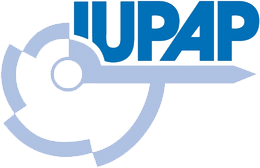
The International Union of Pure and Applied Physics is an international non-governmental organization whose mission is to assist in the worldwide development of physics, to foster international cooperation in physics, and to help in the application of physics toward solving problems of concern to humanity. It was established in 1922 and the first General Assembly was held in 1923 in Paris. The Union is domiciled in Geneva, Switzerland.
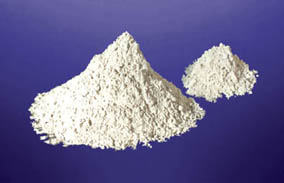
Aluminium nitride (AlN) is a solid nitride of aluminium. It has a high thermal conductivity of up to 321 W/(m·K) and is an electrical insulator. Its wurtzite phase (w-AlN) has a band gap of ~6 eV at room temperature and has a potential application in optoelectronics operating at deep ultraviolet frequencies.
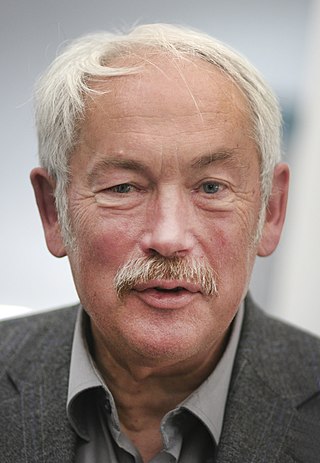
Peter Andreas Grünberg was a German physicist, and Nobel Prize in Physics laureate for his discovery with Albert Fert of giant magnetoresistance which brought about a breakthrough in gigabyte hard disk drives.
Laser-ultrasonics uses lasers to generate and detect ultrasonic waves. It is a non-contact technique used to measure materials thickness, detect flaws and carry out materials characterization. The basic components of a laser-ultrasonic system are a generation laser, a detection laser and a detector.
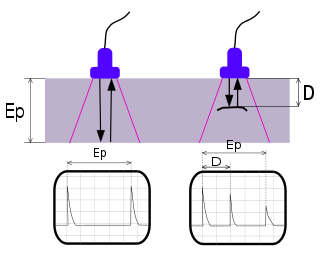
Ultrasonic testing (UT) is a family of non-destructive testing techniques based on the propagation of ultrasonic waves in the object or material tested. In most common UT applications, very short ultrasonic pulse waves with centre frequencies ranging from 0.1-15 MHz and occasionally up to 50 MHz, are transmitted into materials to detect internal flaws or to characterize materials. A common example is ultrasonic thickness measurement, which tests the thickness of the test object, for example, to monitor pipework corrosion and erosion. Ultrasonic testing is extensively used to detect flaws in welds.
D. Jackson Coleman is a professor of clinical ophthalmology at NewYork-Presbyterian Hospital at The Edward S. Harkness Eye Institute of Columbia University. He is the former John Milton McLean Professor of Ophthalmology and chairman emeritus at Weill Cornell Medical Center where he served as chairman from 1979 to 2006. His specialties are retinal diseases and ultrasound, working with patients at Columbia University Medical Center. Coleman is also engaged in research involving ultrasound, which he has pursued throughout his career with colleague Ronald Silverman in the Department of Ophthalmology at the Columbia University Medical Center.

Ultrasonic transducers and ultrasonic sensors are devices that generate or sense ultrasound energy. They can be divided into three broad categories: transmitters, receivers and transceivers. Transmitters convert electrical signals into ultrasound, receivers convert ultrasound into electrical signals, and transceivers can both transmit and receive ultrasound.
Thermographic inspection refers to the nondestructive testing (NDT) of parts, materials or systems through the imaging of the temperature fields, gradients and/or patterns ("thermograms") at the object's surface. It is distinguished from medical thermography by the subjects being examined: thermographic inspection generally examines inanimate objects, while medical thermography generally examines living organisms. Generally, thermographic inspection is performed using an infrared sensor.
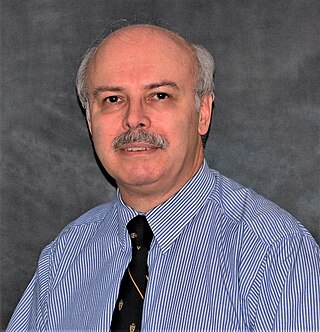
Andreas Mandelis FRSC, FCAE, FAPS, FSPIE, FAAAS, FASME, is Greek physicist who is a professor and researcher in the department of Mechanical and Industrial Engineering at the University of Toronto. He is the director of the Center for Advanced Diffusion-Wave and Photoacoustic Technologies (CADIPT). and of the Institute for Advanced Non-Destructive and Non-Invasive Diagnostic Technologies (IANDIT) at University of Toronto. He is an internationally recognized expert in thermophotonics. and is considered a pioneer in the fields of diffusion-wave, photothermal and photoacoustic sciences and related technologies. His research interests encompass studies of physical energy conversion processes in condensed and biological matter as they impact instrumentation science and signal generation technologies with applications spanning the development of a wide spectrum of novel instrumentation, measurement and imaging techniques using optical-to-thermal, thermoelastic,electronic, ultrasonic and/or photonic energy conversion high-dynamic-range and high-sensitivity analytical methodologies, leading to advanced non-destructive / non-invasive diagnostic, inspection and monitoring technologies with major focus on advanced dynamic imaging instrumentation for industrial and biomedical applications. He is the inventor of a photothermalimaging radar which can detect tooth decay at an early stage, can detect cracks in teeth and monitor dental structural integrity over time. His research team also pioneered and patented 22 analytical instrumentation and measurement methodologies and metrologies.
Štefan Luby is a Slovak physicist and senior research fellow at the Slovak Academy of Sciences (SAS). He is doctor honoris causa of University of Salento, Italy, Slovak University of Technology in Bratislava, University of Constantine the Philosopher in Nitra, Slovakia, and Alexander Dubček University in Trenčín, Slovakia. He occupied positions of the director of the Institute of Physics of SAS for nine years and was the president of the SAS for fourteen years (1995–2009). He was the acting president of the All European Academies and the acting president of the Central European Academy of Sciences and Arts. At present, he is a member of Senate and vice-president of the European Academy of Sciences and Arts with the headquarters in Salzburg. He has chaired the editorial board of the Slovak Encyclopaedia Beliana since 1992.

Timothy Grant Leighton is the Professor of Ultrasonics and Underwater Acoustics at the University of Southampton. He is the inventor-in-chief of Sloan Water Technology Ltd., a company founded around his inventions. He is an academician of three national academies. Trained in physics and theoretical physics, he works across physical, medical, biological, social and ocean sciences, fluid dynamics and engineering. He joined the Institute of Sound and Vibration Research (ISVR) at the University of Southampton in 1992 as a lecturer in underwater acoustics, and completed the monograph The Acoustic Bubble in the same year. He was awarded a personal chair at the age of 35 and has authored over 400 publications.
Warwick Bowen is an Australian quantum physicist and nanotechnologist at The University of Queensland. He leads the Quantum Optics Laboratory, is Director of the UQ Precision Sensing Initiative and is one of three Theme Leaders of the Australian Centre for Engineered Quantum Systems.
Susan Davis Allen is an American engineering professor and academic administrator. She is currently Associate Dean of Research for the College of Engineering and Distinguished Professor of Mechanical Engineering at Embry-Riddle Aeronautical University. Her research has spanned multiple applications of lasers and optics, including spectroscopy, laser sensors, laser ablation, micromachining, and others.
Debora M. Kane is a Professor of Physics at Macquarie University, where her research interests are in non-linear optics and laser physics. She is a Fellow of The Optical Society and has edited four books on nanotechnology, nanomaterials and semiconductor lasers.

Stefan Ulmer is a particle physicist, professor of Physics at Heinrich Heine University Düsseldorf and chief scientist at the Ulmer Fundamental Symmetries Laboratory, RIKEN, Tokyo. He is the founder and the spokesperson of the BASE experiment (AD-8) at the Antiproton Decelerator facility at CERN, Geneva. Stefan Ulmer is well known for his contributions to improving Penning trap techniques and precision measurements on antimatter. He is the first person to observe spin transitions with a single trapped proton as well as single spin transitions with a single trapped antiproton, a significant achievement towards a precision measurement of the antiproton magnetic moment.
Neptunium arsenide is a binary inorganic compound of neptunium and arsenic with the chemical formula NpAs. The compound forms crystals.
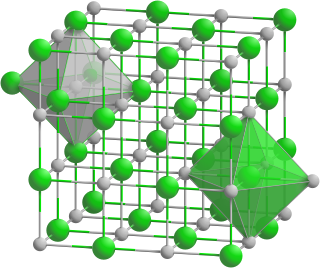
Terbium phosphide is an inorganic compound of terbium and phosphorus with the chemical formula TbP.

Coherent microwave scattering is a diagnostic technique used in the characterization of classical microplasmas. In this technique, the plasma to be studied is irradiated with a long-wavelength microwave field relative to the characteristic spatial dimensions of the plasma. For plasmas with sufficiently low skin-depths, the target is periodically polarized in a uniform fashion, and the scattered field can be measured and analyzed. In this case, the emitted radiation resembles that of a short-dipole predominantly determined by electron contributions rather than ions. The scattering is correspondingly referred to as constructive elastic. Various properties can be derived from the measured radiation such as total electron numbers, electron number densities, local magnetic fields through magnetically-induced depolarization, and electron collision frequencies for momentum transfer through the scattered phase. Notable advantages of the technique include a high sensitivity, ease of calibration using a dielectric scattering sample, good temporal resolution, low shot noise, non-intrusive probing, species-selectivity when coupled with resonance-enhanced multiphoton ionization (REMPI), single-shot acquisition, and the capability of time-gating due to continuous scanning.
References
- ↑ "Council". Institute of Physics. Retrieved 14 January 2015.
- ↑ Porter, R W; Palmer, S B; Langton, C M (1984). "The measurement of broadband ultrasonic attenuation in cancellous bone". Engineering in Medicine. 13 (2): 89–91. doi:10.1243/EMED_JOUR_1984_013_022_02. ISSN 0046-2039. PMID 6540216.
- ↑ Porter RW, Miller CG, Grainger D, Palmer SB (1990). "Prediction of hip fracture in elderly women: a prospective study". BMJ. 301 (6753): 638–41. doi:10.1136/bmj.301.6753.638. PMC 1663899 . PMID 2224217.
- ↑ Strelitzki, R.; Clarke, A. J.; Truscott, J. G.; Evans, J. A. (1996). "Ultrasonic measurement: An evaluation of three heel bone scanners compared with a bench-top system". Osteoporosis International. 6 (6): 471–479. doi:10.1007/BF01629580. ISSN 0937-941X. PMID 9116393. S2CID 26081955.
- ↑ Scruby, C. B.; Dewhurst, R. J.; Hutchins, D. A.; Palmer, S. B. (1980). "Quantitative studies of thermally generated elastic waves in laser-irradiated metals". Journal of Applied Physics. 51 (12): 6210. Bibcode:1980JAP....51.6210S. doi:10.1063/1.327601. ISSN 0021-8979.
- ↑ Dewhurst, R. J. (1982). "Quantitative measurements of laser-generated acoustic waveforms". Journal of Applied Physics. 53 (6): 4064–4071. Bibcode:1982JAP....53.4064D. doi:10.1063/1.331270. ISSN 0021-8979.
- ↑ Davies, S J; Edwards, C; Taylor, G S; Palmer, S B (1993). "Laser-generated ultrasound: its properties, mechanisms and multifarious applications". Journal of Physics D: Applied Physics. 26 (3): 329–348. Bibcode:1993JPhD...26..329D. doi:10.1088/0022-3727/26/3/001. ISSN 0022-3727. S2CID 17358514.
- ↑ Baaklini, George Y.; Edwards, Christopher; Stratoudaki, Theodosia; Dixon, Stephen; Palmer, Stuart B.; Nove, Carol A.; Boltz, Eric S. (2000). "Noncontact ultrasound studies of composite materials: New developments". In Baaklini, George Y; Nove, Carol A; Boltz, Eric S (eds.). Nondestructive Evaluation of Aging Materials and Composites IV. Vol. 3993. pp. 268–275. doi:10.1117/12.385498. ISSN 0277-786X. S2CID 138019031.
{{cite book}}:|journal=ignored (help) - ↑ Baruchel, J.; Aubert, G.; Palmer, S.B.; Schlenker, M. (1986). "Observation of ferro-helimagnetic phase coexistence in Tb crystals". Journal of Magnetism and Magnetic Materials. 54–57: 1631–1632. Bibcode:1986JMMM...54.1631B. doi:10.1016/0304-8853(86)90954-6. ISSN 0304-8853.
- ↑ "NEWS BULLETIN, July 2013" (PDF). IUPAP archive. Retrieved 14 January 2015.
- ↑ "Executive Council: Officers Archive 2002-2014". IUPAP. Archived from the original on 20 January 2015. Retrieved 14 January 2015.
- ↑ "Train Named After University of Warwick Deputy Vice-Chancellor". University of Warwick. Retrieved 14 January 2015.
- ↑ "Phillips Award recipients" . Retrieved 22 December 2019.